Ficus carica L.
Somewhat tender deciduous tree with variable but usually 3-lobed leaves and edible fruit of various shapes and colours. To 10m. [RHSD, Hortus, Hilliers’].
Horticultural & Botanical History
The fruit has been known in western Europe since antiquity and believed to have been grown in Britain since before 1548. [JD]. ‘The Fig Tree. Ficus. It seldom grows to be a tree of any great bigness in England; the leaves are a grass green, and the fruit when ripe of a brownish green; it beareth no visible flowers, which makes it believed they are hid in the fruit. Its native soils are Turkey, Spain and Portugal; and its time of bearing is in spring and autumn; the figs are cured by dipping them in scalding hot lye, made of ye ashes of the cuttings of the tree, and afterwards they dry them carefully in the sun. Figs are esteemed cooling and moistening, good for coughs, shortness of breath and all diseases of the breasts; as also the stone and gravel, - and the small Pox and Measels, which they drive out. Ourwardly they are dissolving and ripening, good for imposthumations and swellings, and pestilential buboes.’ [Blackwell pl.125/1837].
‘The Fig (Ficus carica) is a native of the south of Europe, including Greece and Italy, of Northern Africa and of Western Asia. The wild type known in Italy by the name of Caprifico, has indeed been distinguished by Gasparrini not only as a species but as a separate genus, but we cannot but concur with Prof. Targioni in the opinion, confirmed by positive assertion on the part of practical pomologists both ancient and modern, that our garden figs are of the same species and have repeatedly been raised from seeds of the wild caprifico.
We find mention of the cultivation of figs, and of the high estimation in which these fruits were held, in the very earliest writings, in the Holy Scriptures, as in Homer’s Iliad. Those of Athens were celebrated for their exquisite flavour. Xerxes was tempted by them to undertake the conquest of Attica, in the same way that Cato urged the Romans to that of Carthage, a fig in his hand. The number of varieties, however, produced in ancient Italy were not numerous. Six only were known in the time of Cato. Others were afterwards introduced from Negropont and Scio, according to Pliny, who gives a catalogue of thirty sorts. Their names are mostly taken from the countries whence they had been brought, such as the African, the Rhodiote, the Alexandrine, the Saguntine, &c., or from some great personage who had introduced or patronised them, such as the Pompeian from the great Pompey, the Livian from Livia, the wife of Augustus, &c. Macrobius, two centuries after Pliny, enumerates twenty-five, but generally under names different from those of Pliny. Gallesio, in his Pomona Italiana, has referred a few of those ancient names to modern Italian varieties.’ [JHS vol.9, p.168/1855].
History at Camden Park
Twelve varieties of Fig are listed in the catalogues under Fruit which should be referred to for more detail. Ficus carica is marked with a ‘c’ in an 1836 edition of Loddiges’ catalogue held at Camden Park [CPA]. In William Macarthur’s code, used and explained elsewhere, this means grown at Camden at this time. Figs were almost certainly grown much earlier than this.
Notes
Published Apr 02, 2010 - 02:28 PM | Last updated Apr 02, 2010 - 02:33 PM
| Family | Moraceae |
|---|---|
| Category | |
| Region of origin | Western Asia |
| Synonyms | |
| Common Name | Fig, Common fig |
| Name in the Camden Park Record |
Ficus carica |
| Confidence level | high |


